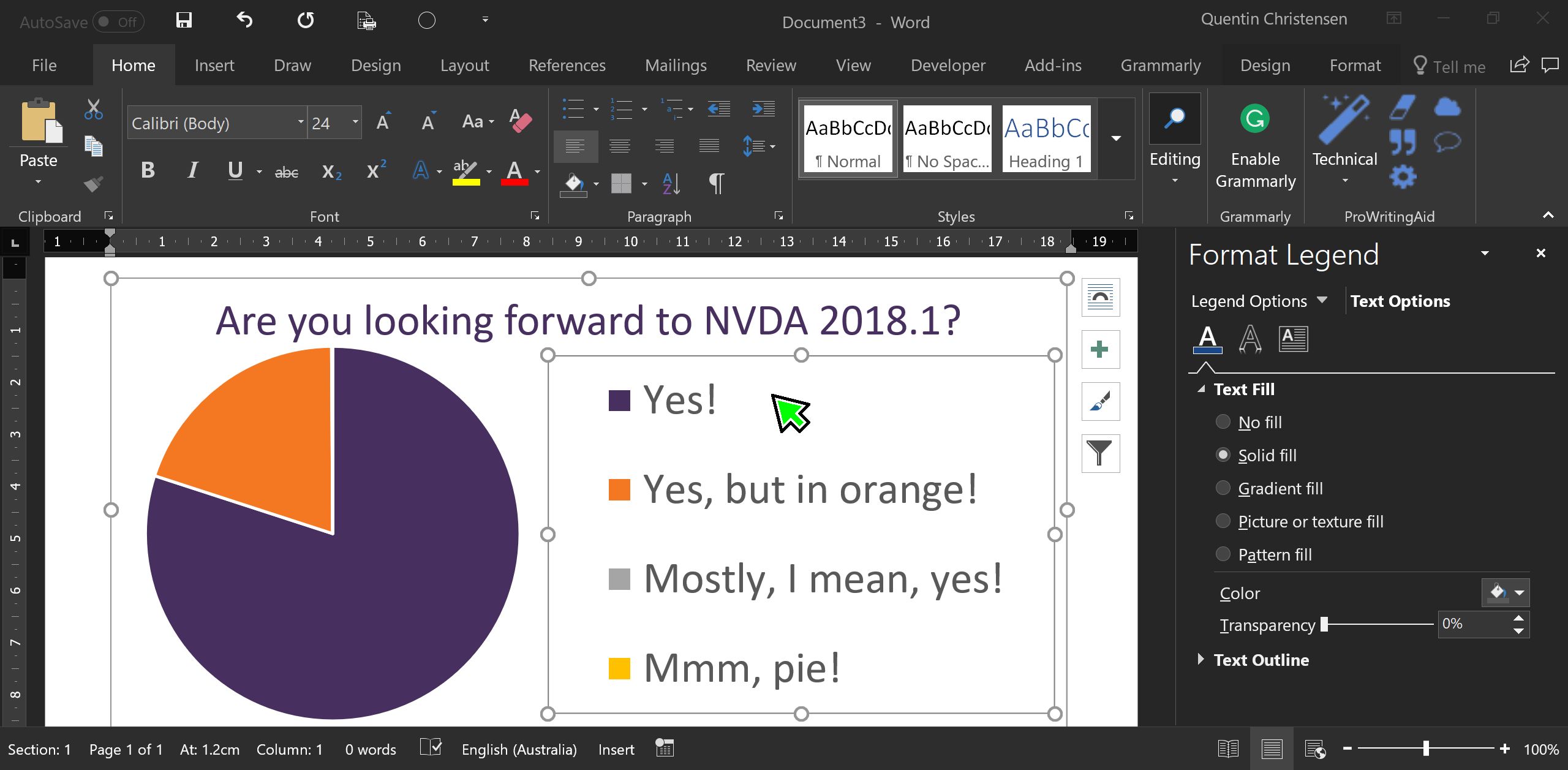Well, the first month of the year is already over, and hopefully, our werewolf followers didn’t get up to too much mischief during last night’s super-blue-blood-moon spectacular!
Here at NV Access, we’ve been busy working on the next version of NVDA, so I thought I’d share a couple of things which are coming up in 2018.1:

Pie chart in Word with title “Are you looking forward to NVDA 2018.1? 80% shows “Yes”, 20% shows “Yes, but in orange” and there are unused data points for “Maybe, I mean, yes” and “Mmm, pie”
Firstly, it is now possible to interact with charts in Microsoft Word and Microsoft PowerPoint, similar to the existing support for charts in Microsoft Excel. The process varies slightly between programs, but broadly, navigate to the chart and press ENTER. When done, press ESCAPE to finish. Also, for recent Office 365 versions of Microsoft Excel, it is again possible to navigate charts using the arrow keys.
When typing with the on-screen keyboard via touch interaction, by default you now need to double tap each key the same way you would activate any other control. If you prefer the existing “touch typing” mode where simply lifting your finger off the key is enough to activate it, enable this option in the new Touch Interaction settings dialog found in the Preferences menu.
It is no longer necessary to explicitly tether braille to focus or review, as this will happen automatically by default. Note that automatic tethering to review will only occur when using a review cursor or object navigation command. Scrolling will not activate this new behaviour.
In Windows 10 Fall Creators Update, NVDA no longer fails to update when Controlled Folder Access is enabled from Windows Defender Security Center.
A heap of bug fixes, Braille improvements and other tidbits.
There is also a slight performance improvement when rendering large amounts of content in Mozilla Firefox 58 and later. Mozilla released Firefox 58 recently, which addresses many of the problems they introduced in Firefox 57. Marco Zehe from Mozilla’s accessibility team has more information on Marco’s Accessibility Blog. He details improvements in Firefox 58, current issues and where things are headed with Firefox. It is well worth a read.
We get queries from time to time from those interested in learning to develop for NVDA, or who just want to know the best environment to use for programming in Python. Python is the main language the majority of NVDA is written in.
There are many tutorials on the web to help you learn Python. As with many languages, you can either use an IDE (Integrated Development Environment) or write the code in your favourite text editor. Up until recently, most IDEs were largely inaccessible. Most NVDA users who write in Python tend to use their favourite text editor. Notepad++ has been a popular choice, but even regular Notepad which comes with Windows will do the job. In the latest versions of Microsoft Visual Studio, Microsoft have made great progress in the accessibility of the editor, and it is now another option if you are interested in writing in an IDE. The advantage of an IDE is it can make it easier to work on a project by automating some of the tasks for you.
If you are interested in coding for NVDA, be sure to check out our NVDA Developer Guide and the NVDA developers’ e-mail list.
On learning to program in Python itself, if you do know of a great tutorial for those interested in learning from scratch, please do let me know and I’ll share it here in a future In-Process.
Finally, back to the question I know you are really interested in – when is NVDA 2018.1 due out? Well, we’re about to enter translation freeze, after which, no new features will be added to 2018.1. This allows the translators to finish updating their translations in time for the final release of 2018.1. So, about the time the next In-Process comes out, in a fortnight or a few days later, the first Release Candidate for NVDA 2018.1 should be available. The final version of NVDA 2018.1 will be out a week or so after that unless any major issues are found. To help identify any potential issues early, do feel free to grab a copy of the current “Master” build from the Snapshots page, as that is very close to what the release candidate build will be like. Of course, if you do identify any issues, please do report them on our GitHub page. If you are reporting an issue specific to the snapshot build, if you could confirm whether it is specific to the latest build, something new since the last stable build, or something since you’ve updated another program, that would really help us track it down.
Until next time, enjoy your February!